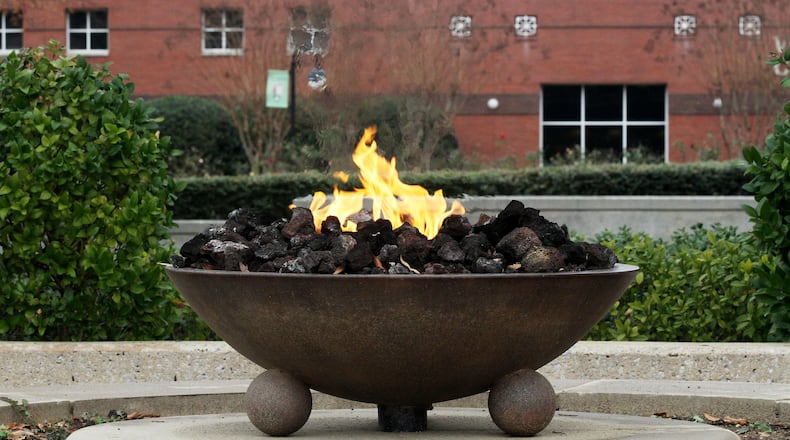Near the end of their lives, I visited with Rosalynn and Jimmy Carter in rural Plains, in the modest ranch-style home where they lived prior to occupying the White House — the same home where they raised their children and spent most of their 77-year marriage.
In their cozy living room, we chatted about fly fishing and politics amid furniture crafted by the former president in his woodworking shop. A child of the Great Depression, Carter was extremely thrifty and never spent money on anything he could make himself. He had no interest in accumulating personal wealth, always declining speaking fees and refusing to profit from the presidency. A farm boy at heart, material possessions meant nothing to Jimmy Carter. Land, however, meant everything.
Credit: arvin.temkar@ajc.com
Credit: arvin.temkar@ajc.com
Profiles of Carter’s presidency highlight peace deals in Panama and the Middle East, or gas shortages, crippling inflation, and the hostage crisis in Iran. He is widely praised as an ex-president for his Nobel-prize-winning work eradicating diseases and enhancing democracy around the world with the Carter Center and for building thousands of homes with Habitat for Humanity. But Carter’s most lasting legacy quietly spreads across the American landscape today like a conservation quilt in the form of the many parks and wild spaces he preserved for posterity.
During his one-term presidency, Carter doubled the size of our National Park System, created 39 new national parks, designated 56 million acres of wilderness for protection under the Antiquities Act and perpetually protected over 150 million acres through the Alaska Lands Act. When nearby clear-cutting threatened California’s redwood forests, Carter doubled the size of Redwood National Park, protecting critical watersheds that have sustained the giant trees for millennia.
Teddy Roosevelt was the only U.S. president to protect more land than Carter, and Carter honored his predecessor by creating Theodore Roosevelt National Park, stretching from the Great Plains to the Badlands, drawing hundreds of thousands of visitors annually to an otherwise sleepy community and contributing nearly $50 million to the local North Dakota economy. Carter created parks large and small, from the giant 6 million acre Denali National Park & Preserve in Alaska to the 39 acre Martin Luther King Jr. National Historic Park in Georgia. In addition to preserving and honoring our nation’s natural and historic treasures, these parks all have one thing in common: They are cash cows.
Historically, every $1 invested in our National Park System directly returns at least $10 to the federal budget. The total economic output of America’s national parks is currently over $55 billion annually, generated by a comparatively low input of just $3.5 billion. More than 300 million visitors from around the globe visit our national parks each year, spending nearly $30 billion in adjacent communities, creating nearly half a million private-sector jobs and $20 billion in additional labor income. All of these data points are available on the National Park Service website in peer-reviewed economic surveys.
No one even remotely serious about ferreting out government waste would lay a finger on the National Park Service. It’s one of the few federal programs that actually makes money, and it does so at a rate that would make the greediest venture capitalist blush. Instead of laying off park rangers or asking them to justify their jobs or take early retirement, we should be telling them to keep up the good work. A truly shrewd businessperson would be looking for further opportunities to invest in the National Park Service, rather than slashing its budget.
I’ve spent my entire 20-year legal career as a private attorney general fighting fraud in government programs and haven’t had one case involving the National Park Service. Meanwhile, my whistleblower clients and I have returned hundreds of millions of dollars to the federal fisc from unscrupulous health care executives, defense contractors and other corporate profiteers bent on defrauding the American taxpayers.
Carter’s investment in our National Park System was both prudent fiscal policy and patriotic recognition that America’s natural beauty is a primary source of her greatness, enhancing the quality of life for hundreds of millions of people – not to mention sequestering carbon, storing groundwater, generating oxygen, filtering air pollutants and helping cool an otherwise rapidly warming planet. Carter didn’t play a single round of golf during his time in the White House, but he traveled with his family to visit our national parks and thereafter continued to camp, fish and paddle in them for the remainder of his life.
Credit: arvin.temkar@ajc.com
Credit: arvin.temkar@ajc.com
At 93, having recently defeated brain cancer, Carter celebrated his 71st wedding anniversary with Rosalynn, friends and family in the Alaskan wilderness he’d fought so hard to protect. Standing in the middle of a wild scenic river, he fought a 26-inch rainbow trout for nearly half an hour before releasing it back into the wild.
A few months ago, Carter died in the same modest home in Plains where I visited with the couple three years prior. Rosalynn predeceased him by just under a year. Upon their deaths, the Carters donated their family home to the National Park Service.
Credit: Jim Barger/contributed
Credit: Jim Barger/contributed
Jim Barger Jr. is a writer and naturalist based on St. Simons Island, and the author of “Jimmy Carter Rivers & Dreams.” He is the founding partner of Frohsin Barger & Walthall, a national law firm dedicated to prosecuting fraud in federal government programs and is a longtime adjunct professor of law who teaches white collar crime at the University of Alabama.
About the Author
Keep Reading
The Latest
Featured



